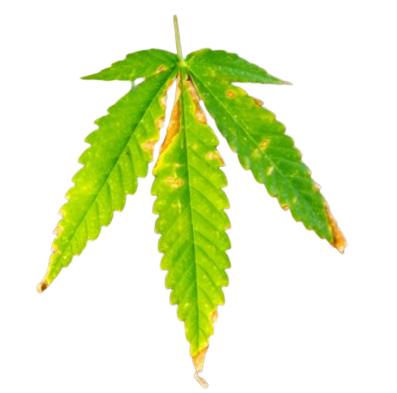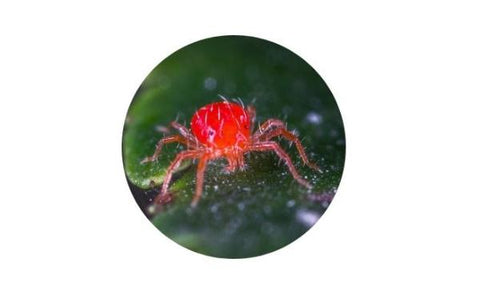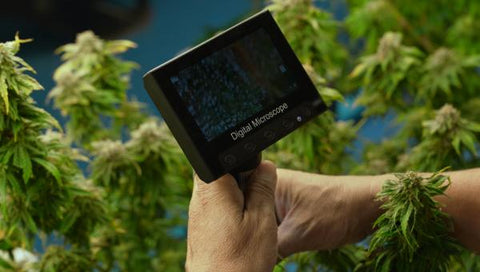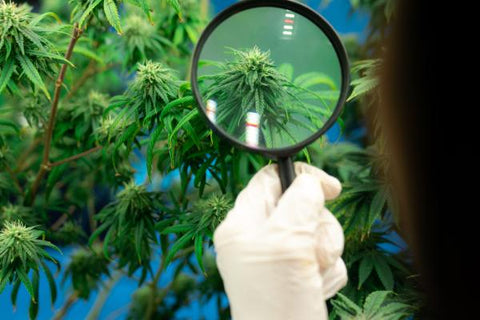Best price on the market

How to combat red spider
Cannabis cultivation, known for its delicacy and specific needs, faces various challenges, one of the most significant being the infestation of the red spider (Tetranychus urticae). This tiny pest, often imperceptible to the naked eye, can wreak havoc on plantations, becoming an obstacle for novice and experienced growers alike. The red spider, characterized by its coloration that varies from pale yellow to dark red, feeds on the cellular content of the leaves, leaving behind a trail of damage and weakness on the plants.
The impact of the red spider on cannabis cultivation is not minor. These mites not only decrease the aesthetic vitality and overall health of plants, but also compromise their ability to develop quality flowers. The decrease in productivity and quality of cannabis can be considerable, making effective control of this pest imperative.
Therefore, understanding how to combat spider mites and how to eliminate spider mites permanently and knowing the red spider treatment options available, including specific insecticides and spider miticide, both homemade and commercial, becomes crucial. We will explore various strategies and treatments to manage this pest, thus ensuring the optimal health and productivity of your cannabis crops.

Identification of the Red Spider in Cannabis Plants
A silent enemy in cannabis cultivation, spider mites can be difficult to detect due to their diminutive size and ability to hide. However, knowing its appearance and the common symptoms it causes in plants is essential for effective control.
Description of the Appearance of the Red Spider
The adult spider mite measures approximately 0.5 mm, making it almost invisible to the naked eye. They are often identified by their color, which can vary from pale yellow to dark red, depending on factors such as species and environmental conditions. These mites are usually found on the underside of the leaves, where they weave fine cobwebs that are a clear indication of their presence.
Common Symptoms in Affected Cannabis Plants
Cannabis plants infested by spider mites show several symptoms, including:
- Yellow or whitish spots : They appear on the leaves due to cellular damage caused by mite feeding.
- Wilted or deformed leaves : Overall leaf health deteriorates as mites continue to feed.
- Thin cobwebs : Mainly on the underside of leaves and between shoots.
- Reduced overall plant vigor : Affected plants typically show slower growth and reduced flower production.
Tips for Early Detection
- Regular Inspection : Examine your plants frequently, paying special attention to the undersides of leaves and new shoots.
- Use of a Magnifying Glass : Given the small scale of these mites, the use of a magnifying glass can be crucial for their early detection.
- Environmental Monitoring : Spider mites thrive in conditions of heat and low humidity. Maintain climate control in your growing area to prevent infestations.
- Pay attention to the first signs : At the first sign of yellow spots or cobwebs, act quickly to confirm the presence of the spider mite.

Conditions that Favor Red Spider Infestation
Spider mites are not only one of the most common marijuana pests and diseases , but also one of the most challenging to control. Their appearance and proliferation are closely linked to certain environmental conditions. Understanding these factors is vital to implement preventive and control strategies.
Environmental Factors That Promote Their Appearance and Proliferation
- High Temperature : The red spider thrives in warm environments. Temperatures between 26°C and 30°C favor its rapid development and reproduction.
- Low Humidity : These mites prefer dry environments. A low relative humidity is ideal for its survival and growth.
- Inadequate Ventilation : Lack of good air circulation can create microclimates that favor red spider infestation.
- Stressed Crops : Plants weakened or stressed by other factors (such as inadequate irrigation or nutritional deficiencies) are more susceptible to attack.
Importance of Constant Monitoring at Different Stages of Cannabis Growth
- Germination and Seedlings : During the early stages, plants are particularly vulnerable. It is crucial to maintain optimal conditions to avoid the stress that attracts mites.
- Vegetative Stage : As plants grow, the surface area available for spider mites increases. Monitor regularly for early signs of infestation.
- Flowering Stage : This critical stage requires even more rigorous monitoring. Spider mites can cause significant damage to buds, directly affecting cannabis quality and yield.
- Harvesting and Curing : Although less common, it is important to ensure that the plants are free of pests before proceeding to these final stages.

Prevention methods
Prevention is always the best strategy in pest management, especially in the case of red spider mites in cannabis crops. Implementing proper cultural practices and preventive strategies can significantly reduce the risk of infestation.
Strategies to Prevent the Appearance of the Red Spider
- Environmental Control : Maintain a growing environment with moderate temperatures and adequate relative humidity. Avoid conditions that favor the development of spider mites, such as excessive heat and low humidity, and know at what temperature spider mites die .
- Adequate Ventilation : Make sure your growing space has good air circulation. This not only prevents the appearance of favorable microclimates for mites, but also strengthens the plants.
- Crop Hygiene : Regularly clean and disinfect your growing area, including tools and surfaces. Prevents the introduction of pests through contaminated plants or substrates.
- Biological Control : Uses natural enemies of the red spider, such as predatory mites (Phytoseiulus persimilis), as a preventive control method.
Recommended Cultivation Practices to Reduce the Risk of Infestation
- Routine Inspection : Examine your plants regularly for early signs of infestation. Pay special attention to the underside of the leaves.
- Plant Stress Management : Keep your plants healthy and stress-free, as weak plants are more susceptible to pests. This includes proper watering, balanced nutrition and disease prevention.
- Use of Physical Barriers : Implement physical barriers, such as fine mesh, to protect plants from external intruders.
- Crop Diversification : Diversifying plants in your garden can help prevent the spread of spider mites, as some plants can act as natural repellents or attract beneficial predators.

Chemical Solutions: When and How to Use Them
Although organic methods are preferred by many, in certain situations, especially cases of severe spider mite infestations, the use of chemical solutions may be necessary. Every grower should know how to eliminate spider mites from cannabis plants and choosing the right insecticide and applying it safely and effectively is crucial to controlling the pest without causing additional damage to the plants or the environment.
Information on Chemical Insecticides Effective Against Red Spider
- Red spider miticide : Products specifically designed to combat mites, such as red spider mites. These may be more effective than general insecticides.
- Pyrethroids : Chemical compounds that act on the nervous system of mites. However, its use must be managed with care due to its possible toxicity and resistance.
- Horticultural Oil Insecticides : Although less aggressive than other chemicals, they can be effective in controlling mites when used correctly.
- Systemic Insecticides : These products are absorbed by the plant and can be effective against pests that feed on it, such as red spiders.
Tips for Safe and Effective Use, Minimizing the Impact on the Plant and the Environment
- Read and Follow Instructions : Before applying any insecticide, read the instructions carefully and follow them to the letter.
- Use in the Correct Dose : Apply the recommended amount. Excessive use can damage plants and contribute to pest resistance.
- Careful Application : Avoid spraying on windy days or high temperatures to reduce drift and volatilization.
- Product Rotation : Alternate between different types of insecticides to prevent spider mite resistance.
- Personal Protection : Wear appropriate protective equipment during application to avoid exposure to chemicals.
- Consider Time to Harvest : Take into account the product's withdrawal period to ensure there are no residues in the harvested cannabis.
- Environmental Impact : Consider the long-term impact on your garden ecosystem and the environment in general.
Advantages
- High Efficiency : They are generally more effective in quickly and completely controlling severe infestations.
- Fast Action : They offer fast results, which is crucial in advanced infestations.
- Broad Spectrum : Many have a broad spectrum of action, affecting several pests at the same time.
Disadvantages
- Toxicity Risk : They can be harmful to the environment, consumers and plants if not used properly.
- Pest Resistance : Prolonged use may lead to the development of resistance in pests.
- Impact on Beneficial Insects : They can damage or eliminate populations of beneficial insects.
When to use
- Suitable for severe infestations where organic methods are not sufficient.
- When a quick solution is required to save a crop at risk.
- In situations where pest control is a priority over the organic purity of the product.

Organic and Ecological Treatments
When it comes to combating spider mites in cannabis cultivation, organic and ecological treatments are preferred options for many growers. These methods are not only effective against mites, but are also safe for plants, the environment, and consumers of the final product.
Organic Treatment Options to Combat Red Spider
- Insecticide Soap (homemade spider mite insecticide) : Potassium-based soaps are effective in physically eliminating mites by rupturing their cell membranes.
- Garlic or Hot Pepper Extracts : These natural solutions act as repellents and can help prevent infestation.
- Essential Oils : Oils such as peppermint, eucalyptus or lavender can be effective in repelling spider mites. They should be used with caution to avoid damaging plants.
- Biological Control : Introducing natural predators of the spider mite, such as Phytoseiulus persimilis mites, is an effective organic strategy.
Importance of Choosing Safe and Environmentally Friendly Methods
- Plant and Soil Health : Organic spider mite treatments are less aggressive for plants and soil, maintaining a healthy ecosystem in your garden.
- Safety for Consumers : Especially relevant in cannabis cultivation, organic methods ensure that the final product is free of toxic residues.
- Preservation of Biodiversity : By avoiding harmful chemicals, beneficial fauna that contributes to the natural balance of the ecosystem is protected.
- Long-Term Sustainability : Organic treatments promote sustainable practices, reducing dependence on chemicals and minimizing environmental impact.
Advantages
- Environmental and Health Safety : Organic treatments are safe for the environment, consumers and plants, minimizing toxicity risks.
- Maintenance of the Garden Ecosystem : They promote biodiversity and preserve beneficial insects.
- No Pest Resistance : Reduces the risk of pests developing resistance, a common problem with chemicals.
- Sustainability : They are more sustainable solutions in the long term and friendly to the natural environment.
Disadvantages
- Less Powerful in Severe Infestations : They may not be as effective in cases of severe or advanced infestations.
- Require More Frequent Application : They often need to be applied more regularly than chemicals.
- Slower Response Time : They may take longer to show visible results.
When to use
- Ideal for prevention and in mild to moderate infestations.
- Preferable in crops where the aim is to maintain a totally organic product.